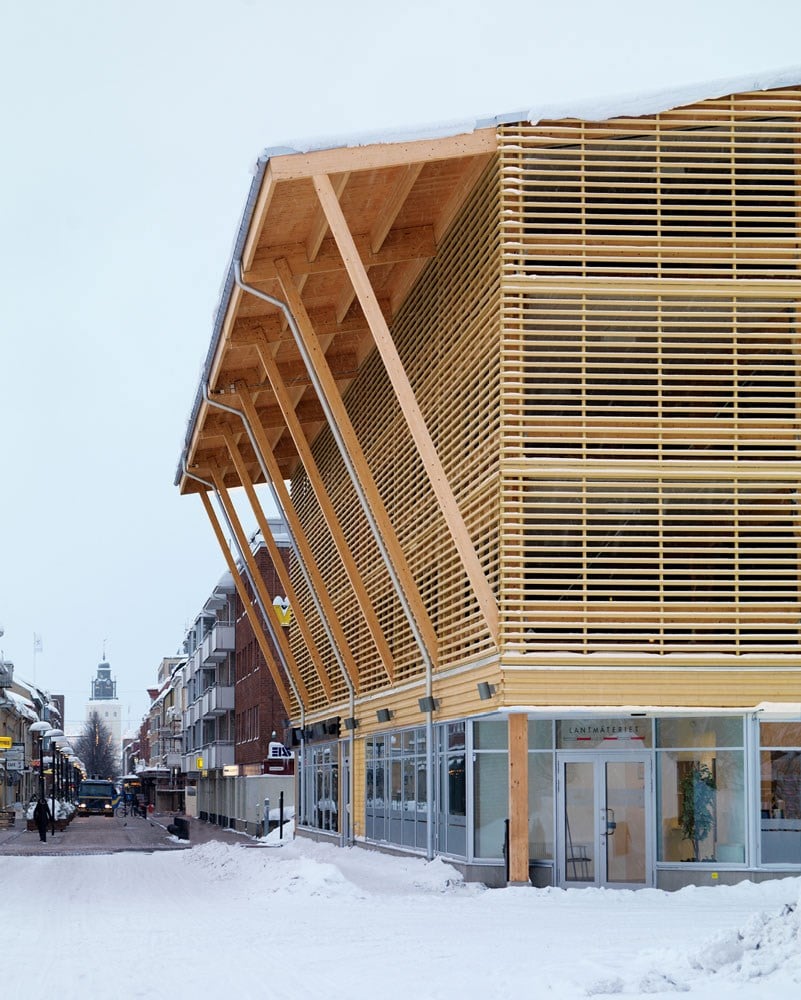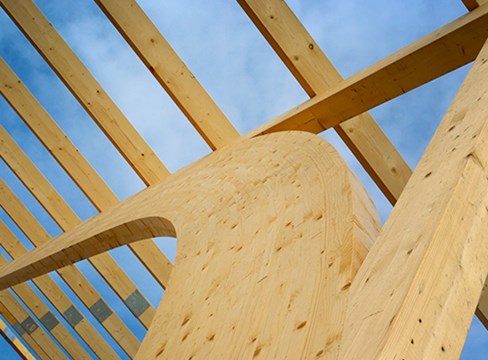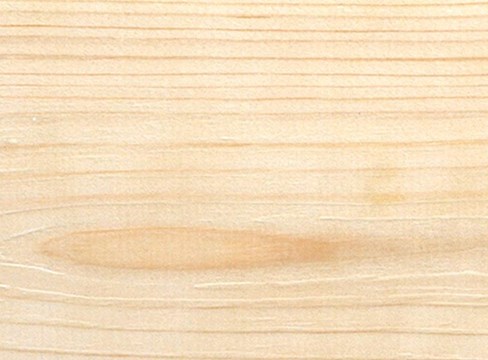Structural elements
Many wood products for structural purposes are made from timber that is glued together. Other wood products or other materials, such as metal, might also be included. Many different types of adhesive and methods may be used to glue wood together.
Roof trusses
Roof trusses are usually manufactured industrially as finished products and must be CE-labelled according to the standard SS-EN 14250. The wood used is construction timber, usually 45 mm thick.
The parts are joined together with nail plates that are pressed into the wood at the joints. All the wood lies on the same plane, which makes the insulation work easier for the house manufacturer or on the construction site.
The technique can be used to prefabricate all types of load-bearing wood elements. Software has been developed in line with Eurocode 5 to aid with the design of roof trusses.
The roof trusses should be handled and stored in a vertical position, well protected from precipitation and ground moisture.
Roof trusses can also be made on site using calculation data that follows Eurocode 5. The materials for roof trusses, such as construction timber, nail plates and anchor screws or anchor nails, should be CE-marked and accompanied by a performance declaration.
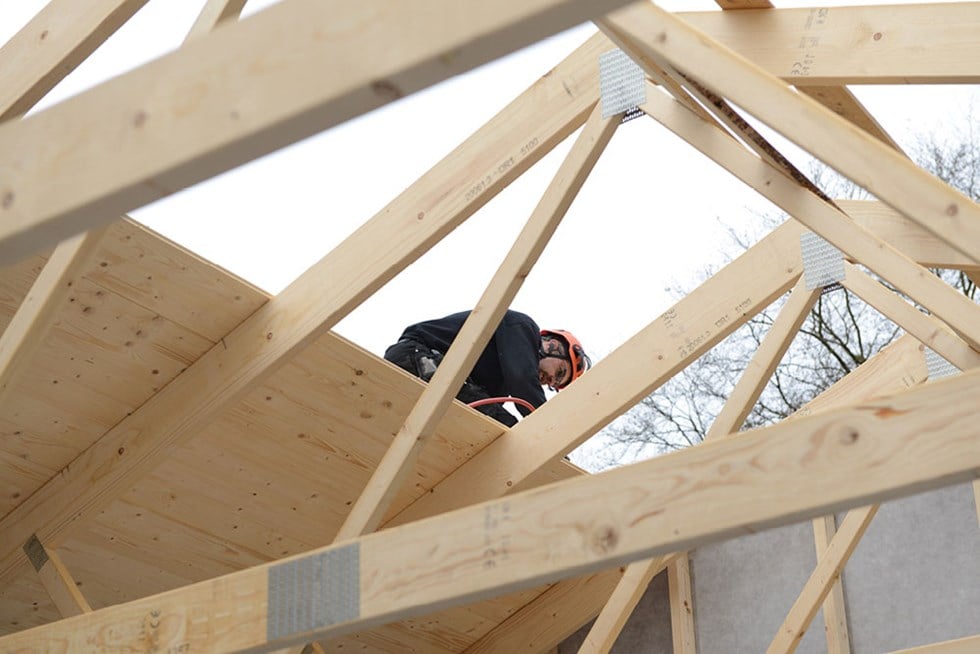 Assembly of roof trusses with temporary bracing.
Assembly of roof trusses with temporary bracing.
Glulam
Glulam is an engineered wood product designed primarily for load-bearing structures. In relation to its weight, glulam is one of the strongest construction materials available. Sometimes it is used in exposed supporting structures and as a defining feature of a space.
Glulam load-bearing frames are common in halls and public buildings, and have become increasingly widely used in high-rise apartment blocks. Bridges are another key area of use, while the use of glulam in low-rise buildings is also on the up.
Manufacture and control
Glulam structural elements are manufactured industrially under controlled conditions. Large lengths can be achieved using finger-jointing technology. The principle of production is that finger-jointed laminates of wood are stacked up in layers and glued together into large structural elements. The wood fibres are oriented in the direction of the glulam products’ length. The size and length of the glulam products are limited in the first instance by transport options and in the second instance by the glulam manufacturer’s production site and equipment.
Swedish glulam is produced in line with the requirements set out in standard SS-EN 14080 and must be CE-marked.
The thickness of the laminates for straight glulam products is 45 mm. The manufacturing standard for the Swedish market is strength class GL30, whatever the number of layers. The number 30 represents the characteristic bending strength expressed in MPa (N/mm2).
Combined glulam has at least four layers and is specified using the letter c. Glulam in strength class GL30c comprises laminates of strength class T22 in the outer zones and strength class T15 in the inner zone. For combined glulam in strength class GL30c, the outer zone laminates must be 2 × 17% of the cross-section height h.
Homogenous glulam has fewer than four layers and is designated with the letter h. Glulam in strength class GL30h comprises laminates in strength class T22 throughout.
Glulam split beams (b less than 90 mm) are usually made from glulam beams of strength class GL30, but after splitting with a bandsaw, the resulting parts lose up to 2 MPa in bending strength and are therefore classified as GL28cs (cs = combined split). Glulam split beams are manufactured with a height to width ratio of less than or equal to 8:1.
Manufacturing glulam requires considerable precision, not least regarding the milling of the finger-joints, glue preparation and application, pressure and timing. In-house controls take place on a rolling basis to ensure that glulam products maintain consistent, high quality, and this involves taking regular samples from the production line to check for strength and other performance factors. Glulam manufacturers are third-party certified by accredited certification bodies.
Properties
Glulam is primarily a construction material, making strength, stiffness and durability generally the most important characteristics. Glulam products therefore tend not to have the same wood grade and surface finish as interior joinery and furniture. In most contexts, the standard products meet normal appearance requirements.
Swedish glulam is made primarily from spruce (Picea abies), but pine (Pinus sylvestris) is used in specific cases, such as when the glulam needs to be made from treated wood.
The glulam manufacturing process uses synthetic adhesives that are documented as having high strength and durability under a prolonged load, and that have a long and proven track record. The relevant requirements are set out in standard SS-EN 14080 and sometimes in the subsidiary standard SS-EN 301, which classifies two adhesive types, Type I and Type II. Glulam produced with Type I adhesive can be used no matter what the ambient climate (Climate classes 1–3 in Eurocode 5), while the use of Type II adhesive is restricted to structures that are protected from the weather (Climate classes I and II in Eurocode 5). Glulam should, however, always be protected against the long-term effects of damp, rain and sun. In Sweden, glulam is manufactured almost exclusively using melamine-urea-formaldehyde (MUF) adhesive, which is a Type I adhesive. The proportion of adhesive in glulam is less than one percent by weight.
The high strength and stiffness of glulam enables large unsupported spans to be achieved. With construction timber, the strength of an individual plank is determined by the weakest cross-section – usually at a large knot or area of cross-grain. The strength of different planks can vary significantly. On average, glulam elements are both stronger and stiffer than an individual plank of the same dimensions. This is because of the lamination effect, which can briefly be explained as follows:
A glulam element comprises a number of laminates (boards) made from construction timber. There is only a very small risk of strength-reducing defects in several laminates occurring in the same cross-section. The wood laminates are also strength-graded and the strongest laminates are placed in the outer zones, where the stresses are normally greatest.
Load-bearing capacity in a fire depends on the dimensions of the structure, how much of the load capacity is already being used, and the structural design of the bonds and connections.
Although glulam is a flammable material, its large and homogenous cross-section makes it relatively stable during the initial stages of a fire. The larger the dimensions, the greater the load-bearing capacity in a fire. Glulam is slow to catch fire and it burns slowly. The way the heat develops during a fire is often crucial in determining whether the fire will spread or burn out. The charred layer that forms on the surface of the glulam in a fire protects the inner parts and helps the glulam to retain its load-bearing capacity as the fire continues. Glulam burns slowly at an almost constant rate (approx. 0.5–1.0 mm per minute) because of the charred layer that forms on the surface of the glulam element. Burning glulam only generates moderate amounts of smoke.
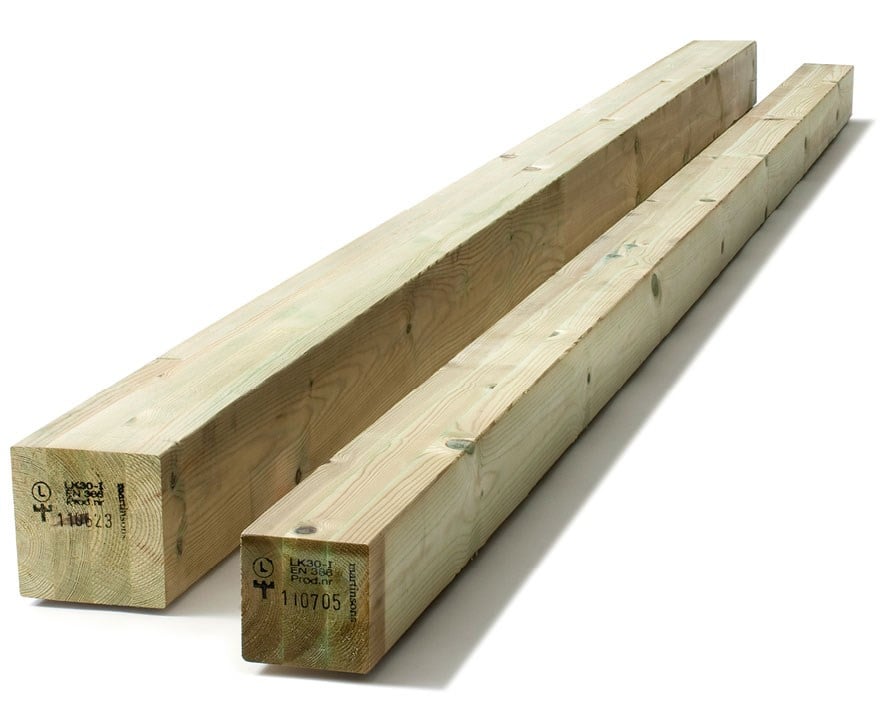 Pressure-treated glulam post.
Pressure-treated glulam post.
Appearance grade
“Clean-planed finish, no surface repairs” is the stock appearance grade. The sides are planed. Pitch pockets, small knot holes, tear-out and glue deposits are permitted. Exposed edges should be bevelled. The stock grade is recommended for visible use, for example in roof beams in sports halls, business premises, schools and low-rise housing.
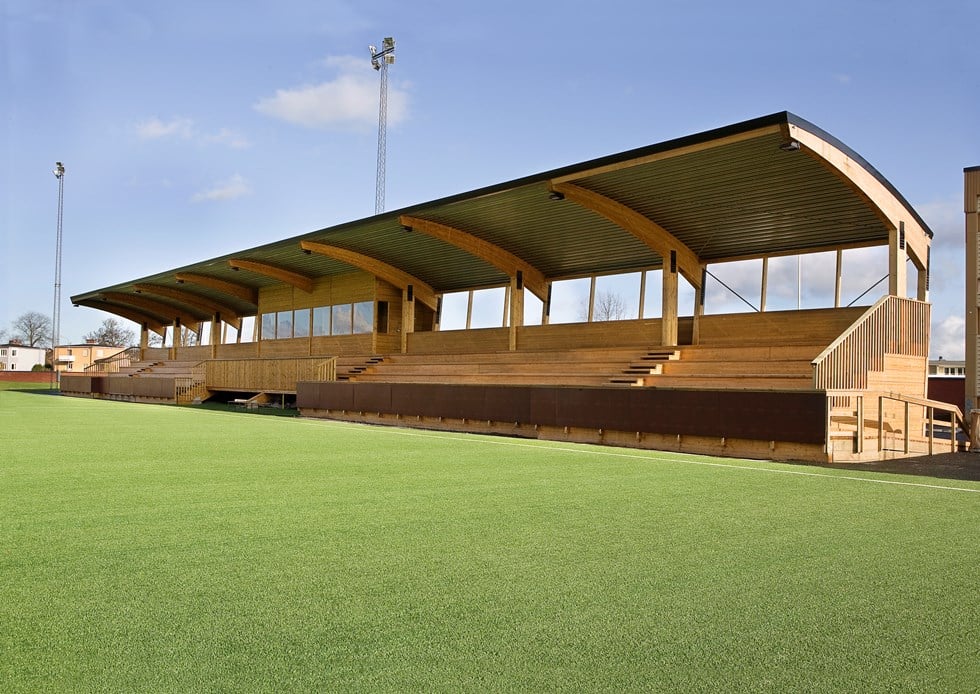 Glulam grandstand, Vänersborg.
Glulam grandstand, Vänersborg.
Range
Glulam products are produced as straight or curved elements. The most common cross-section shape is rectangular, but other cross-sections can be manufactured on request. Straight elements with a rectangular cross-section are standardised in terms of dimensions and appearance grade. Page 81 provides an overview of the glulam product range.
Straight glulam elements are stocked as standard beams in lengths of up to 12 m in a strength class as described on page 81, Type I adhesive, appearance grade Clean-planed, no surface repairs and untreated.
Glulam with an h value of less than 180 falls into strength class GL30h (homogeneous glulam) while glulam with an h value of 180 mm or more falls into strength class GL30c (combined glulam). Elements with a b value of less than 90 mm, known as glulam split beams, fall into strength class GL28cs (combined split glulam). Other lengths and cross-sections are available to order. Glulam is also available in pressure-treated versions.
Laminated Veneer Lumber (LVL)
The construction material laminated veneer lumber (LVL) is closely related to plywood. The product is manufactured industrially in the form of homogeneous beams with a rectangular cross-section, which serve primarily as load-bearing beams in buildings and other structures.
LVL is a laminated wood product comprising at least five layers of pine or spruce bonded together in an industrial process. During the bonding process, the layers of adhesive-covered veneer are pressed together under high pressure and high temperature. The adhesive is a water-resistant phenolic resin. All the veneers are oriented so that the fibres run along the length of the beam – a laminated wood product with max. 6 mm thick veneer layers, usually of spruce, which are oriented in the same direction. The layers of LVL beams are thus not stacked with the fibres in alternating directions, as they are in plywood, which is a sheet material.

Fig. 86 Appearance grades Glulam can be supplied in the appearance grades above.
LVL beams are best suited for encasing due to their appearance. The surfaces are rough and untreated, the edges sharp, but the beams offer high strength and stiffness. The moisture content at manufacture and delivery is 10% ± 2%.
Table 28 Common dimensions of LVL beams
|
LVL beams (mm) |
|
|
Width, b |
45, 51, 63 and 75 |
|
Height/depth, t |
200, 220, 260, 300, 360, 400 and 500 |
|
Length, l |
4,000, 6,000, 8,000 and 12,000 |
Table 29 Common dimensions of LVL sheets
|
LVL sheets (mm) |
|
|
Width, b |
up to 2,500 |
|
Thickness, t |
21, 24, 27, 33, 39, 45, 51, 57, 63 and 69 |
|
Length, l |
2,400–13,500 |
LVL beams are subject to a harmonised standard covering factors such as manufacture, strength, controls and labelling. The product should be CE-marked and accompanied by a performance declaration. Product data and information on which to base the dimensioning of LVL beams can be obtained from the manufacturer.
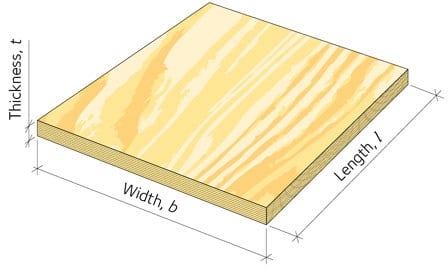
Fig. 89 Sheet of LVL
LVL is used primarily for load-bearing beams, but can also be produced as a sheet material for large-scale, load-bearing uses such as roof lining and subfloors. The structure is the same as for LVL beams – an odd number of at least 7 layers, each 3 mm thick. Sheets of LVL can be manufactured to the standard dimensions described in table 29.
The product is usually made from spruce veneer and has an unsanded surface. The adhesive is a water-resistant phenolic resin. The density of the finished sheet is approx. 500 kg/m3. LVL sheets are available to order with a finely sanded surface, a choice of surface veneer, calibrated thickness and so on.
LVL is subject to a harmonised standard, and should be CE-marked and accompanied by a performance declaration. For use and dimensioning, check the manufacturer’s instructions and product information. See also the product range at www.vilmabas.se.
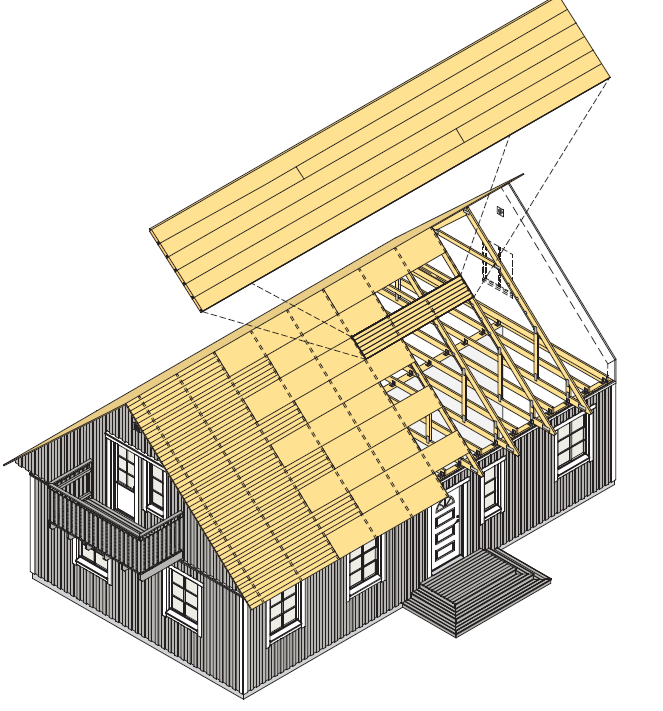
Fig. 80 Fitting T&G sheathing panels
Lightweight joists and beams
Wood-based lightweight beam systems comprise structural glued beams, studs, sill plates and various accessories. The products are industrially manufactured under controlled conditions. The basic idea behind them is that they save on materials and offer high strength. The cross-sectional shape of the components is an I-beam with flanges of construction timber and a web of 10 mm thick particleboard of type P5 or some other wood-based sheet material. The flanges can vary in size from normal to wide.
A lightweight beam system can simplify construction, minimise waste and ensure consistently high product quality. The manufacturer is able to perform bespoke additional services such as hole cutting, precision cutting, oblique cutting, reinforcement, rafter tails, web insulation and connection plates.
The constituent products are CE-marked and have European Technical Approval (ETA). Manufacturing and self-auditing are overseen by independent certification bodies.
Using a lightweight beam system allows for light structures with high thermal insulation capacity and good acoustic properties. The system is suitable for floor structures and walls when building energy-efficient housing, such as nearly zero-energy buildings (NZEB), or for structures that separate different apartments.
Wood-based lightweight beams are manufactured as standard with a height of up to 500 mm and normally stocked in lengths of 6.0–13.3 m. The maximum length is 18.3 m. For use and dimensioning, check the manufacturer’s instructions and product information. Page 82 provides an overview of the available lightweight beams, joists, sill plates and top plates.
Cross Laminated Timber (CLT)
Cross-laminated timber (also known as CLT, crosslam and X-lam) is a product manufactured industrially in the form of sheets, slabs, posts and beams, made of strength-graded boards or planks glued together in alternating perpendicular layers. It is widely used for the structural components of carcasses for high-rise buildings, schools, nurseries, industrial buildings, low-rise housing, bridges and specialist constructions.
The key feature of CLT elements is that they can be manufactured in large dimensions with high load-bearing capacity and stiffness. CLT elements allow for a high degree of prefabrication, and their low self-weight provides many benefits in terms of transport, foundations and assembly.
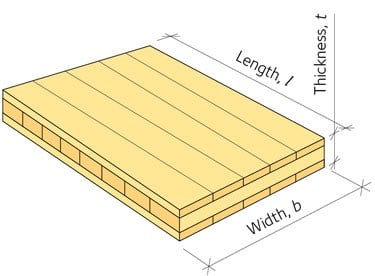
Fig. 91 Sheet of CLT A CLT panel comprises three, five or seven layers. The thickness of each layer may vary.
The combination of advanced manufacturing techniques and good performance makes CLT one of the most important frame materials, with many unique properties:
- High flexibility.
- High strength in relation to its own weight.
- Small manufacturing tolerances and good dimensional stability.
- Good load-bearing capacity in fire.
- Good heat insulation capacity.
- Low self-weight, which means lower transport and assembly costs, as well as simpler and cheaper foundations.
- Good capacity to tolerate chemically aggressive environments.
- Flexible production that even allows the manufacture of curved surfaces.
CLT was introduced into Sweden as an engineered wood in the late 1990s, but the technique has been in use for several decades in Central Europe, and Austria in particular. CLT structures are characterised by fast and simple assembly of prefabricated surface units or modular units. The components can be joined using simple and traditional methods.
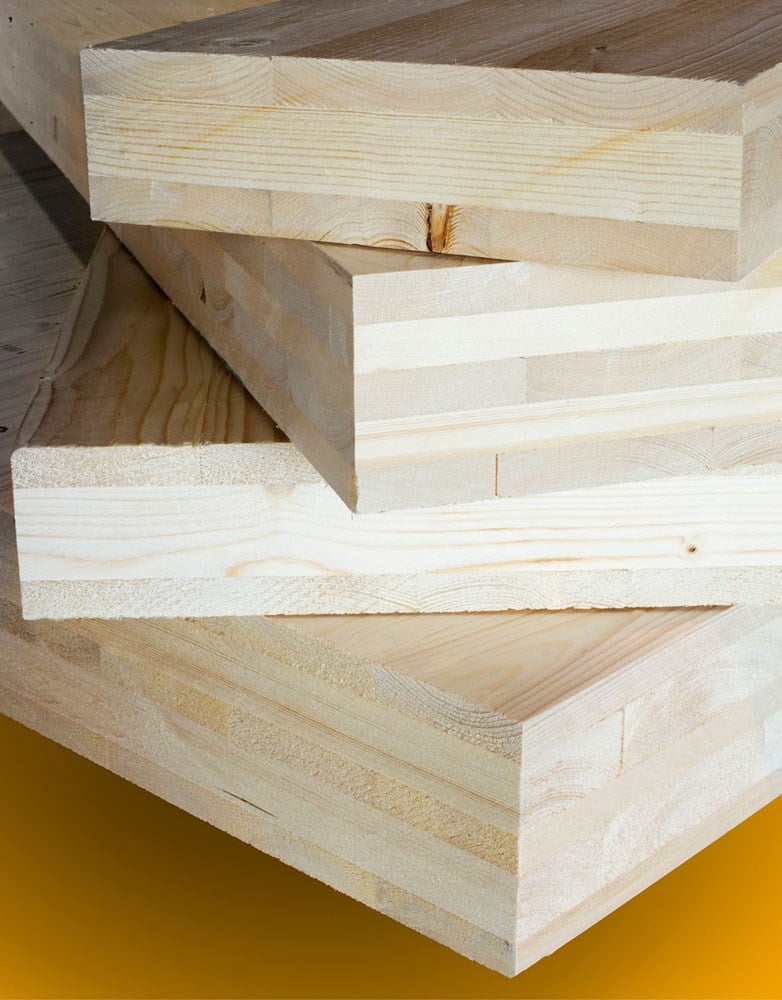 CLT panels
CLT panels
CLT as a construction material
CLT is a highly engineered wood product that is excellent for all sorts of different structures. Its structure and method of manufacture allow for large spans and a variety of designs.
Cross-laminated timber has excellent strength and stiffness properties, which mean that CLT can compete with other more traditional structural materials in large structures that are subject to strict fireproofing and sound insulation requirements.
CLT manufacture
CLT is a sheet material comprising at least three layers of glued boards or planks, usually made from pine or spruce, with each layer placed at 90 degrees to the next. CLT products are made primarily to a common European standard and meet the product properties declared by the manufacturer in their European Technical Approval (ETA)* or in a type approval.
* Until European standard SS-EN 16351 for CLT becomes a harmonised standard, CLT products are certified via a European Technical Approval (ETA), which, like a harmonised standard, contains instructions on procedures for certification, type testing and manufacturing checks.
CLT panels are made up of boards or planks with a thickness of 20–60 mm. The raw material is finger-jointed and strength-graded timber. To make best use of the timber’s strength, wood of higher strength is used in the surface layer and in the main direction of the load, where the stresses are normally greatest. After the adhesive is applied, the boards or planks are forced together under pressure and then the resulting panel is finished off with processes such as sawing the edges, milling recesses, cutting holes and so on.
Properties of CLT
CLT is an engineered material that can be used for architecture in an industrialised way, with extensive prefabrication of structural elements. With all the excellent properties that CLT displays, it can be used with confidence as a construction material. CLT advances the cause of industrial manufacture by being a material that is renewable and easy to work with.
Table 31 Appearance classes, example
|
Appearance class |
May occur |
Not permitted |
|
Exposed surface |
A few pitch pockets under 3 × 40 mm, black knot less than 10 mm, dead knot less than 10 mm, sound knot |
Bark-encased scars, open scars, firm/loose rot, pith, insect attack, wane, knot hole, decayed knot, encased knot, notches, splits (not seasoning checks), glue deposits |
|
Industrial surface |
A few pitch pockets under 3 × 40 mm, black knot less than 20 mm, dead knot less than 20 mm, sound knot, pith, knot hole, notch to minor extent, glue deposits |
Bark-encased scars, open scars, firm/loose rot, insect attack, wane, decayed knot, encased knot, splits (not seasoning checks), eye-catching knot clusters |
|
Non-visible surface |
Pitch pockets, knot holes, black knots, decayed knots, dead knots, notches, encased knots, sound knots, pith, splits, insect attack, glue deposits, colour differences between boards, minor blue stain |
Firm rot, loose rot |
Dimensions
The largest width × length for CLT panels is around 3.5 × 20 m. Three-layer panels normally come in thicknesses from 60 to 120 mm. The standard thicknesses for 5-layer panels range from 100–200 mm.
Floor structures with CLT slabs are self-supporting up to approx. 5 m. Composite (hybrid) floor structures in glulam and concrete can be used for spans of up to 12 m.
Table 30 Common dimensions for CLT sheets.
Designations, see fig. 91.
|
Parameter |
Commonplace |
Available |
|
Thickness, t |
80–300 mm |
60–500 mm |
|
Width, b |
1.20–3.00 m |
up to 4.80 m |
|
Length, l |
16 m |
up to 30 m |
|
No. of layers |
3, 5, 7, 9 |
Up to 25 |
Strength of CLT
The structure of CLT, with its perpendicular layered boards or planks, evens out the variations in the wood and reduces the differences in strength. Strength is determined to a large extent by the composition of the cross-section. Like other wood products, it varies according to the angle between the stress and fibre direction, and falls as the moisture content rises. For use and dimensioning, check the manufacturer’s instructions and product information.
CLT and fire
CLT and structures made from CLT have good, predictable properties when it comes to fire. CLT is slow to catch fire and it burns slowly. Although CLT is a flammable material, the required load-bearing capacity can be maintained in a fire by combining it with other materials. The way the heat develops during a fire is often crucial in determining whether the fire will spread or burn out. The charcoal layer that forms on the surface in a fire protects the inner parts – the penetration rate for wood is generally 0.6–1.1 mm per minute. Structural fireproofing of CLT structures is dealt with in detail in The CLT Handbook.
CLT and sound
As with other lightweight structures, low-frequency sound is difficult to insulate against in CLT structures. In most cases, flanking transmission must be minimised in order to achieve a good sound environment, and there are various technical solutions for this. A structural frame in CLT meets the acoustic requirements set out in Boverket’s Building Regulations (BBR). Testing proves compliance with the BBR requirements. Read more in The CLT Handbook.
Effect of moisture
The alternating structure of glued boards or planks results in only very small moisture-related movements, since the cross-lamination prevents lateral expansion. CLT products are manufactured with a target moisture content of 12%, which means that individual products may have a moisture content on delivery of no higher than 16%.
It is well-known that log cabins have a pleasant indoor climate. Like log cabins, CLT carcasses have a capacity to store moisture and heat. There is minimal risk of moisture-related damage occurring due to moisture diffusing out through a CLT carcass. CLT with a thickness of more than 70 mm can in many cases function as a vapour retarder and removes the need for an extra layer to prevent diffusion through the structure. However, air movements in expansion gaps and other gaps may create concentrations of moisture, which is why it is important to fit these with some form of sealing layer, such as age-resistant tape.
Thermal properties of CLT
CLT demonstrates very little in the way of temperature-related movement, compared with many other products. As with other softwood mass timber, thermal conductivity and thermal capacity are low. The thermal conductivity, which describes the material’s insulating capacity, is significantly better than for concrete and steel. The practically applicable lambda value (λ) for CLT is 0.12–0.13 W/m °C. CLT has a relatively high specific thermal capacity, which is usually stated as around 1,300 J/kg °C. When building with a CLT frame, the large quantity of wood will have an effect on the indoor climate by evening out short-term climate variations.
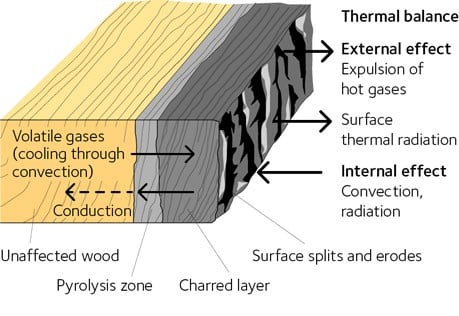
Fig. 92 The phenomenon of the charring process
Appearance
CLT is primarily seen as a structural material whose key properties are strength, stiffness and durability. It is considered to meet normal appearance requirements, as long as the boards are handled with sufficient care in transit and on the construction site. CLT manufacturers have divided CLT into three different appearance classes. Information on what is and is not permitted in the different appearance classes can be obtained from the CLT manufacturer, or see The CLT Handbook.
Applications for CLT
CLT can be used to form the frame of everything from low-rise housing, high-rise buildings, schools, nurseries, industrial buildings and public buildings to car parks, halls, sports arenas, office blocks, bridges for road, pedestrian and cycle traffic, and specialist structures. The characteristic feature of structural components in CLT – for walls and floor structures – is their size. Large cross-sectional areas ensure that CLT panels have a high load-bearing capacity and stiffness.
Walls and floor systems
Walls are generally part of a building’s load-bearing carcass, but in many instances their function is only protection and separation. CLT panels can serve as a load bearer while also performing a separating function.
A wall made of CLT panels can range from simple surface units to a multilayered structure where each layer has its own function, such as thermal insulation, façade material, windows, doors and internal cladding.
A floor structure with CLT as the load-bearing element is usually supplemented with separating layers and with a surface layer in the form of flooring and a ceiling finish. It should be designed so that it meets the relevant requirements concerning fire, sound and thermal insulation.
The simplest form of floor that uses CLT is a flat plate floor structure. High standards of fire resistance and sound insulation can be achieved with a cassette floor, where the CLT slab is reinforced with glulam beams and flanges and with a suspended ceiling below.
Apartment balconies and access balconies
Apartment balconies, access balconies and mezzanine floors, not to mention lift shafts and stairwells, are other areas where CLT is used to great effect, along with car parks and bridges. Using CLT for these applications provides a host of benefits compared with building in other materials.
CLT offers infinite possibilities, limited only by the designer’s imagination.
Tongue & groove sheathing panels
Tongue & groove sheathing panels are made industrially for more efficient roof boarding. The tongue & groove boards that make up the panels should be spruce, grade G4-3 or better, with a thickness of 20 or 23 mm. The width is 550 mm with a coverage width of 540 mm. The length of the tongue & groove sheathing panels is tailored to the standard roof truss spacing of around 1,200 mm, so they are available in lengths of 2,400, 3,600 and 4,800 mm. One or two faces on the tongue & groove sheathing panel are grooved – the surface is finely ridged to combat discolouration and microbial growth on the underside of the boarding – or one face is grooved and the other three sides are planed.
Note that the grooved side should be installed facing downwards, into the attic space. Other sizes can be made to order. Tongue & groove sheathing panels should be used where the wood will be exposed under the eaves. The panels are from tongue & groove boards of grade G4-2 or better.
Tongue & groove sheathing panels should be connected with a butt joint over a support. Some tongue & groove sheathing panels are type-approved for resistance to failure when stepped on. See also www.vilmabas.se. Tongue & groove sheathing panels are supplied untreated or industrially primed with a target moisture content of 16%.
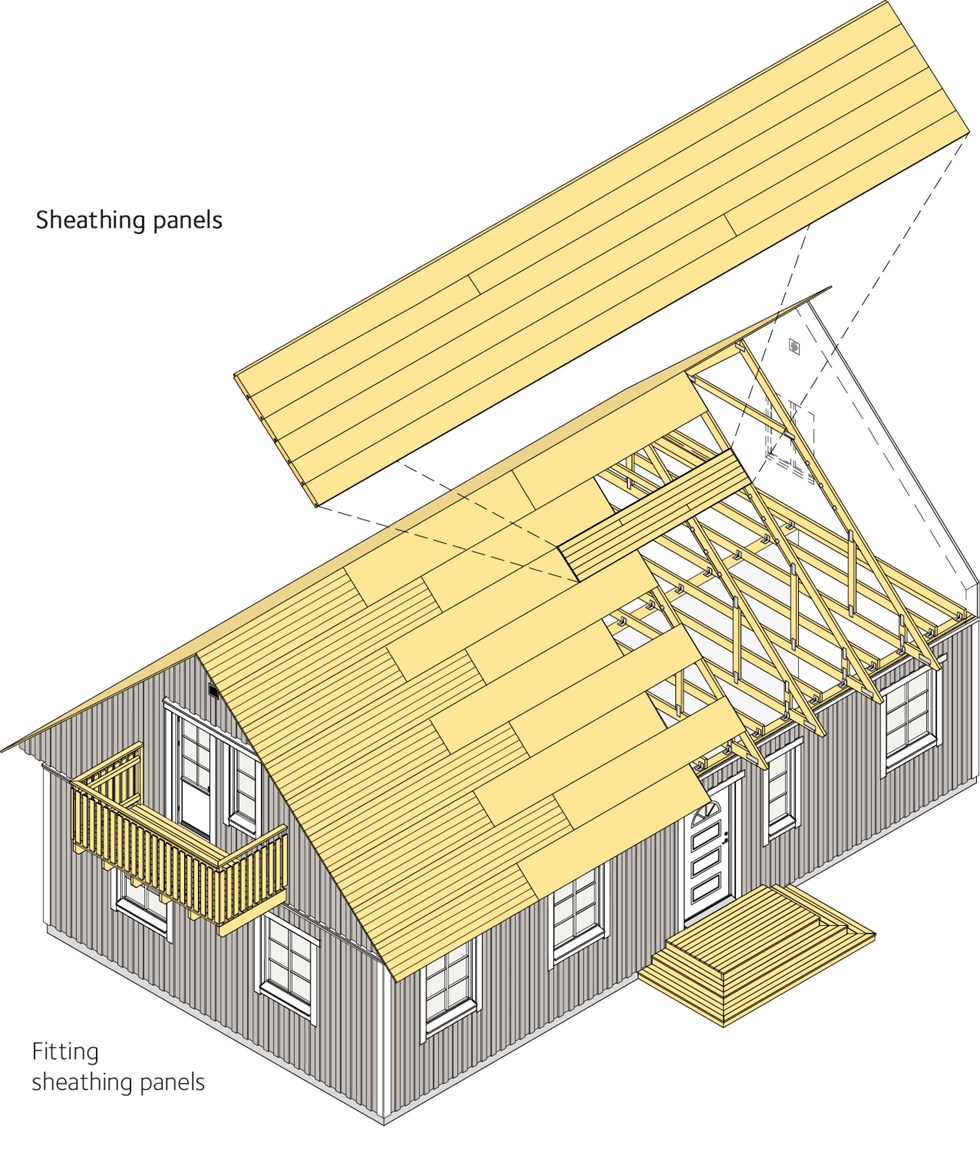

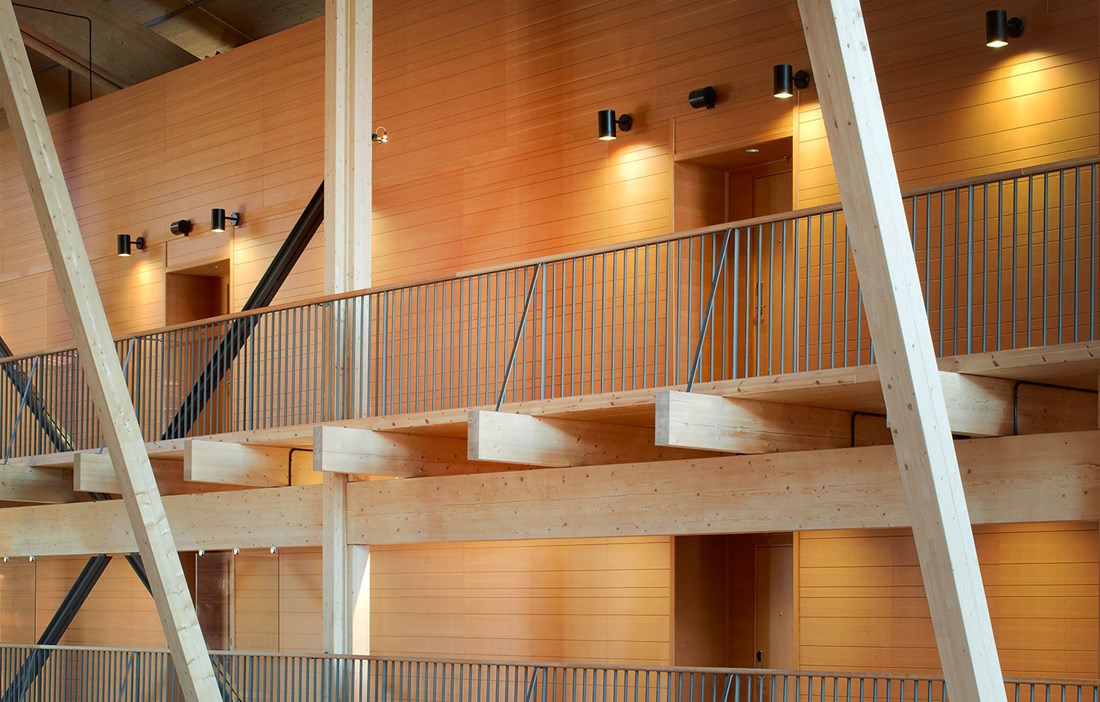
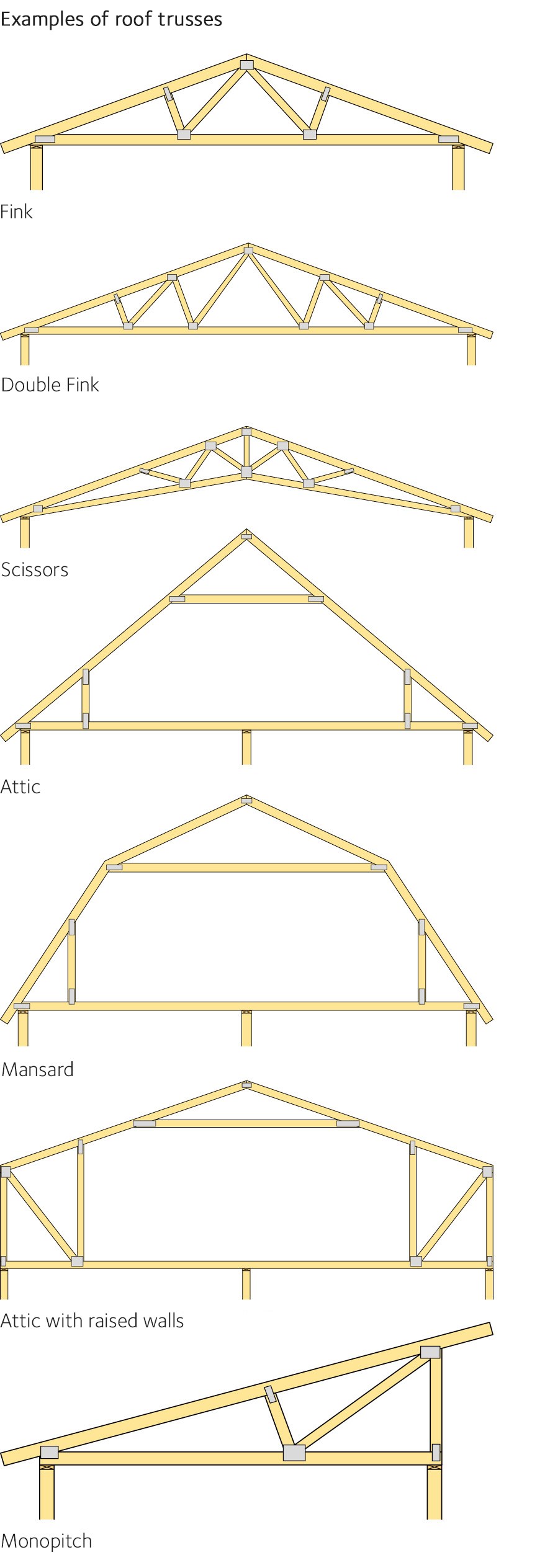
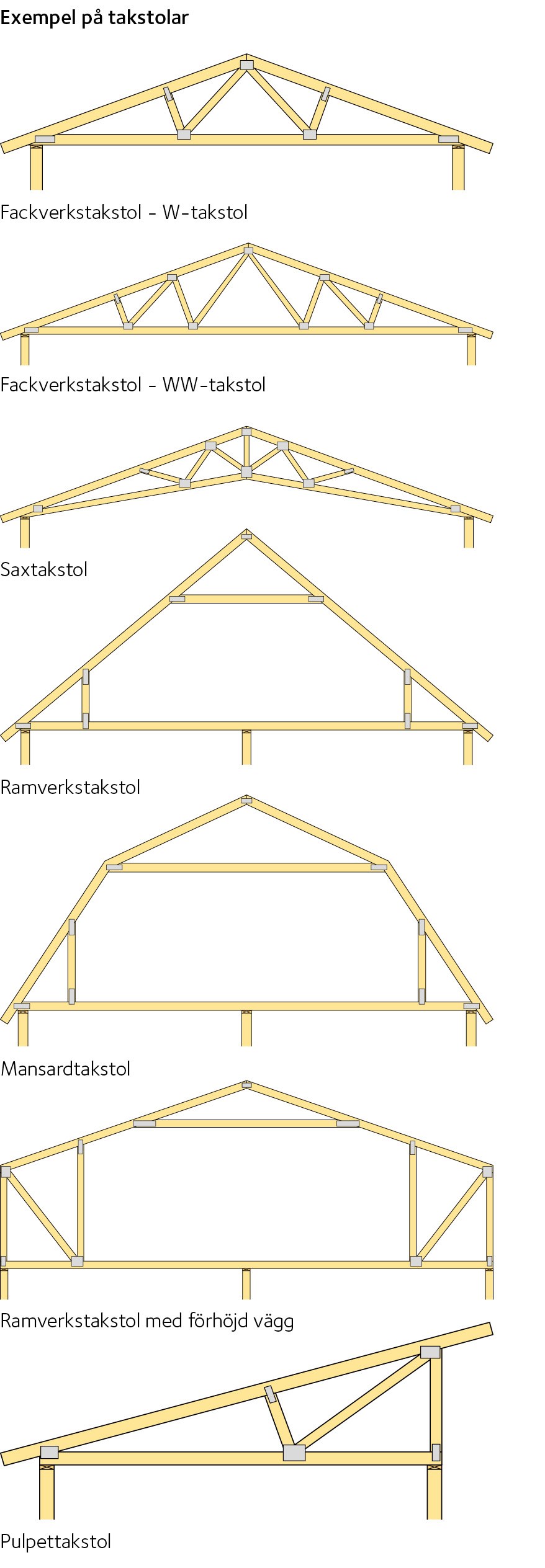
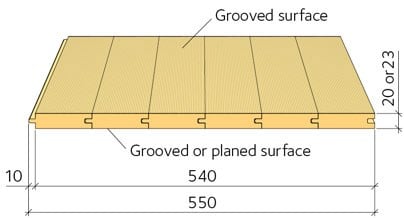
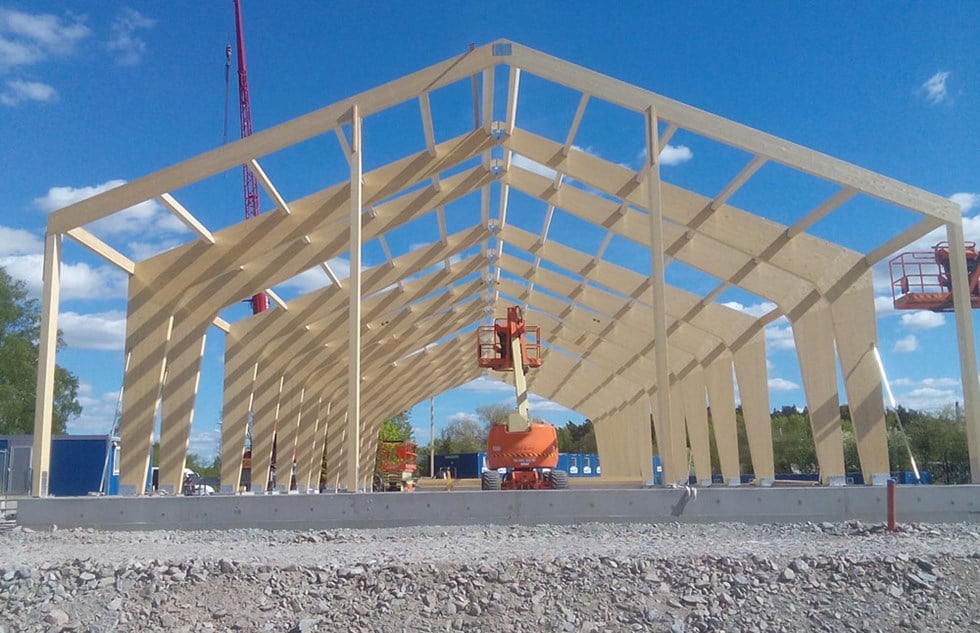 Warehouse, Sollentuna.
Warehouse, Sollentuna.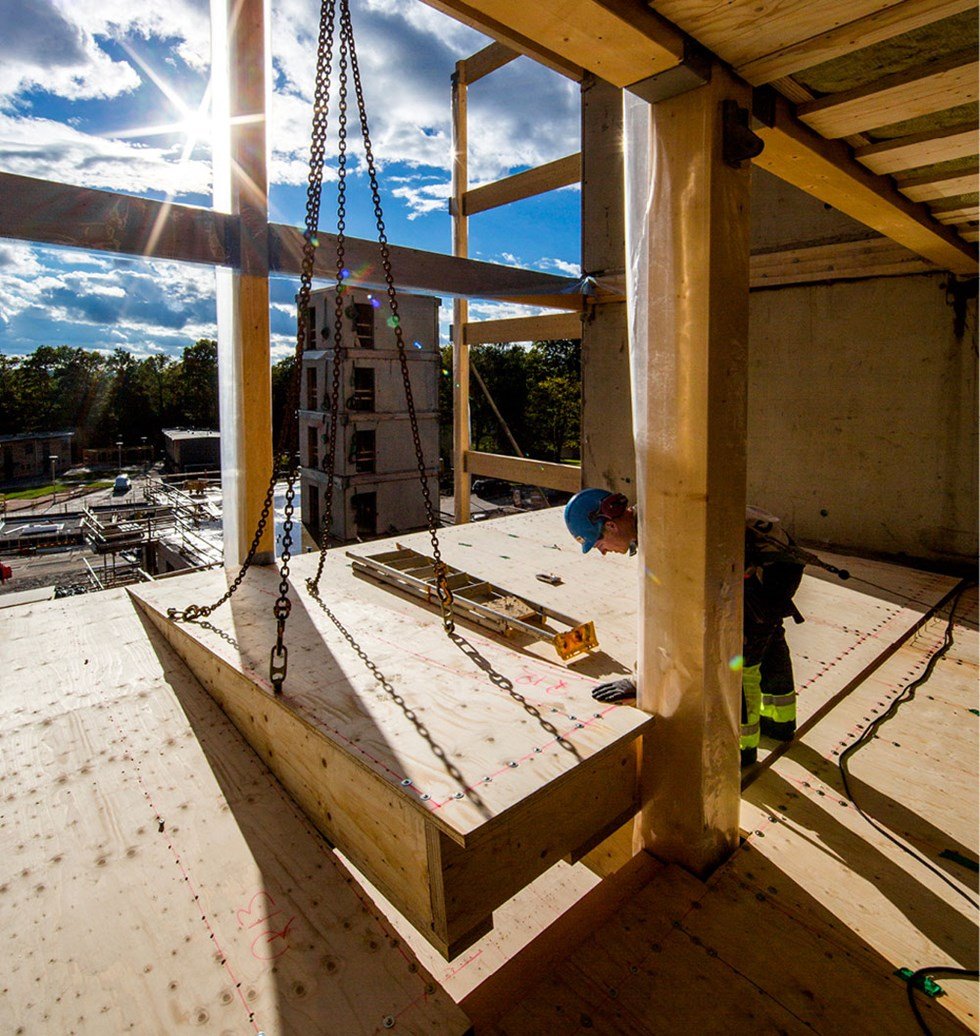 Askims torg, Göteborg.
Askims torg, Göteborg.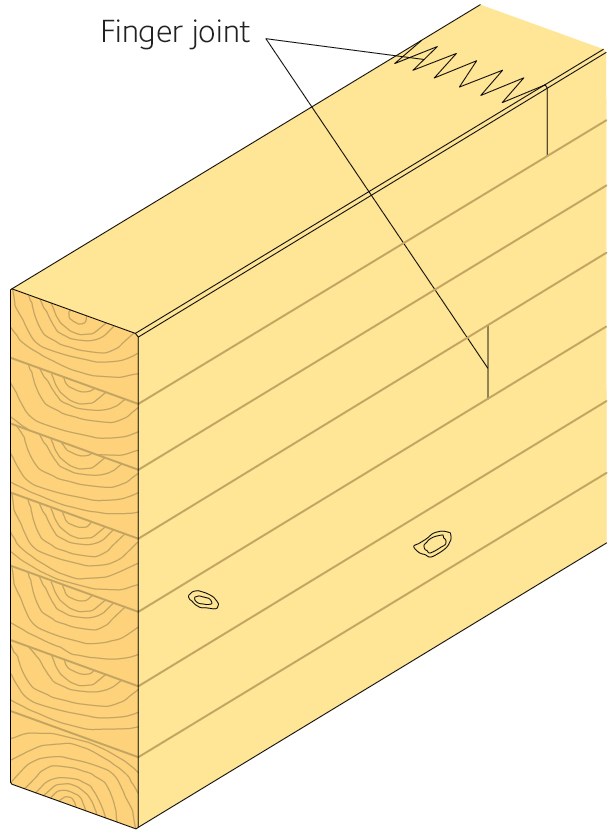
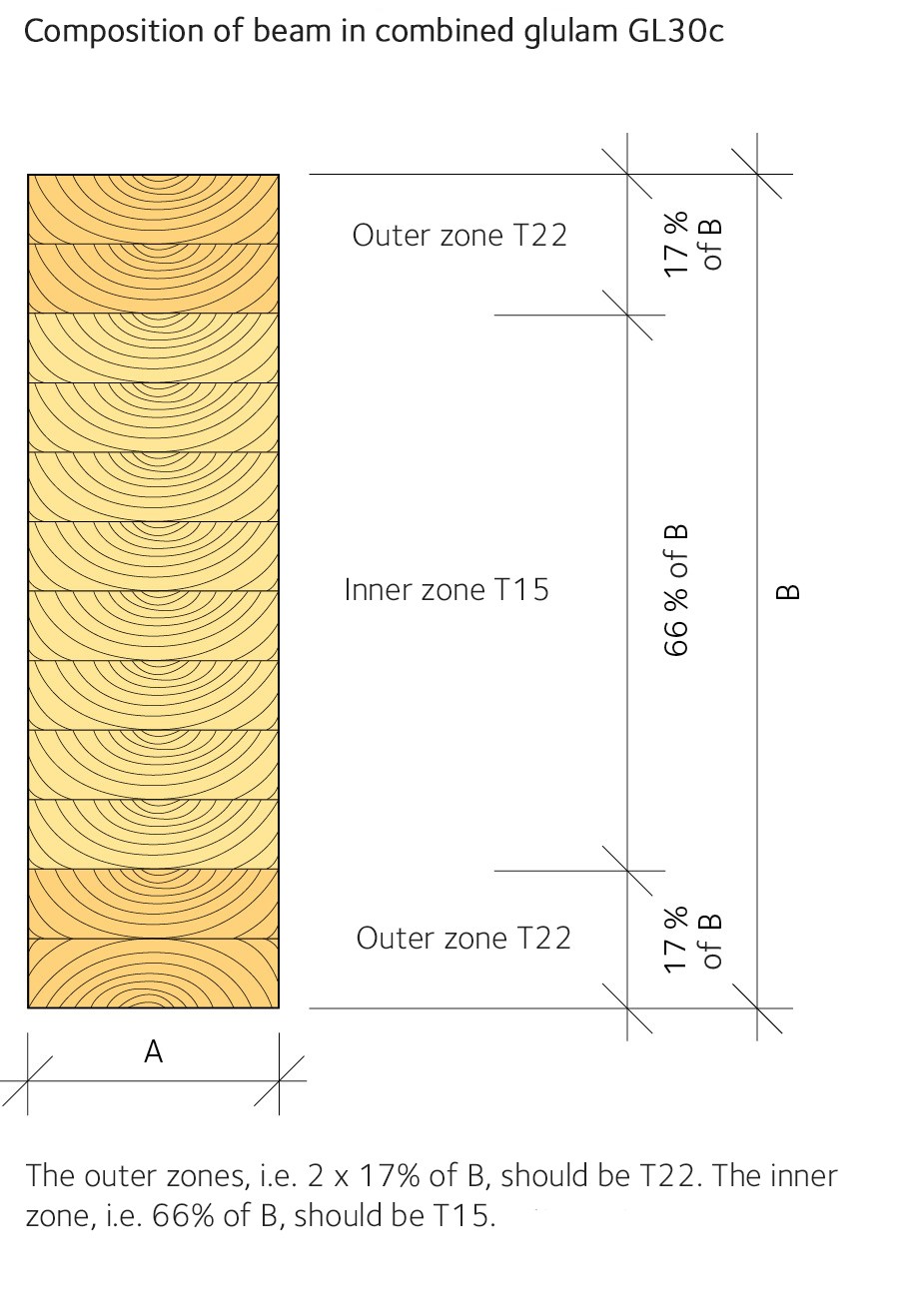
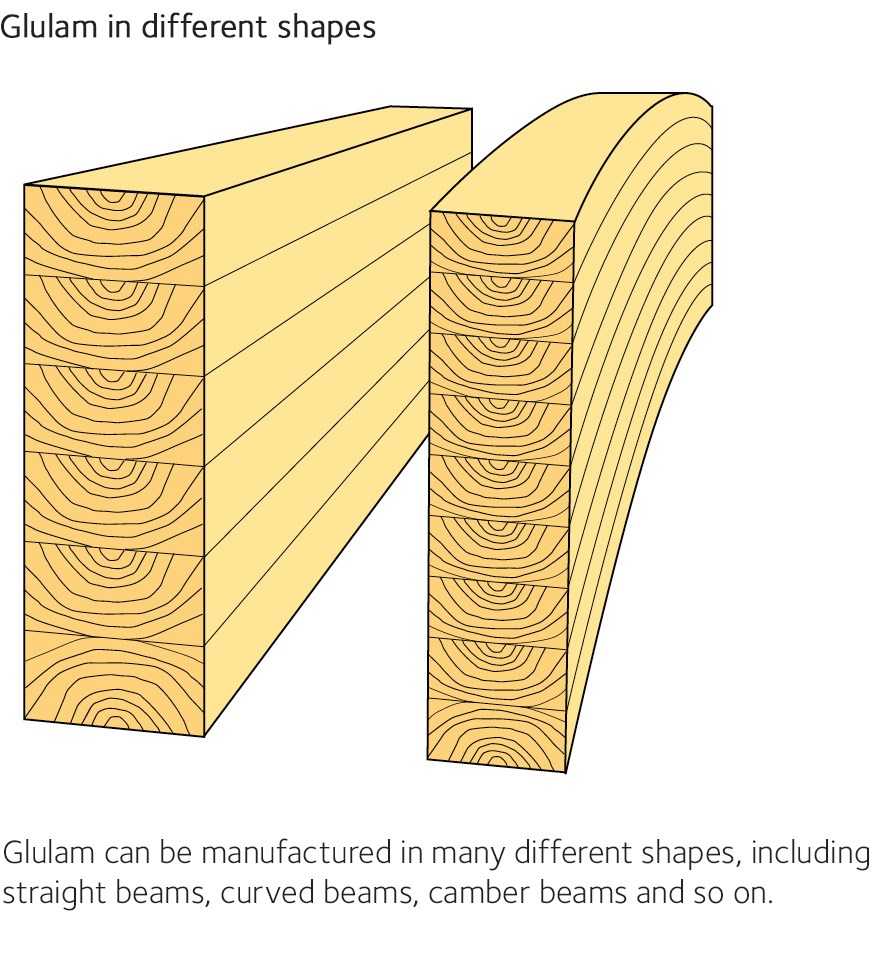

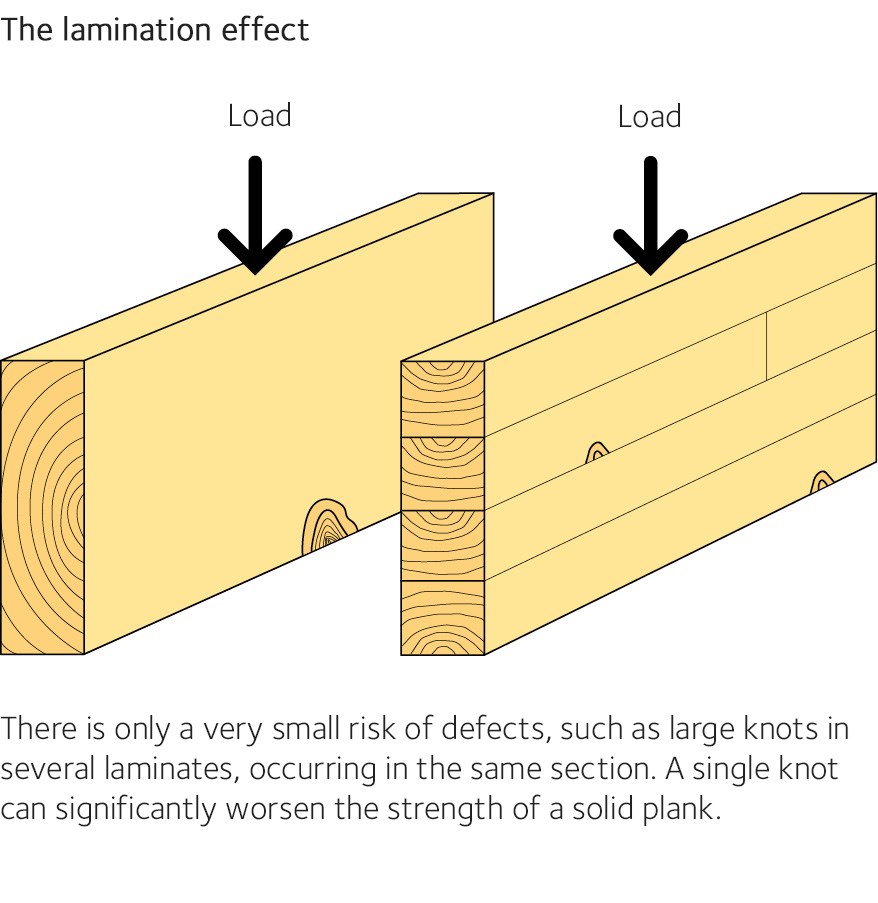 Fig. 85 The lamination effect
Fig. 85 The lamination effect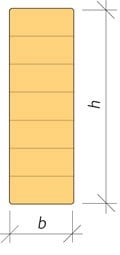
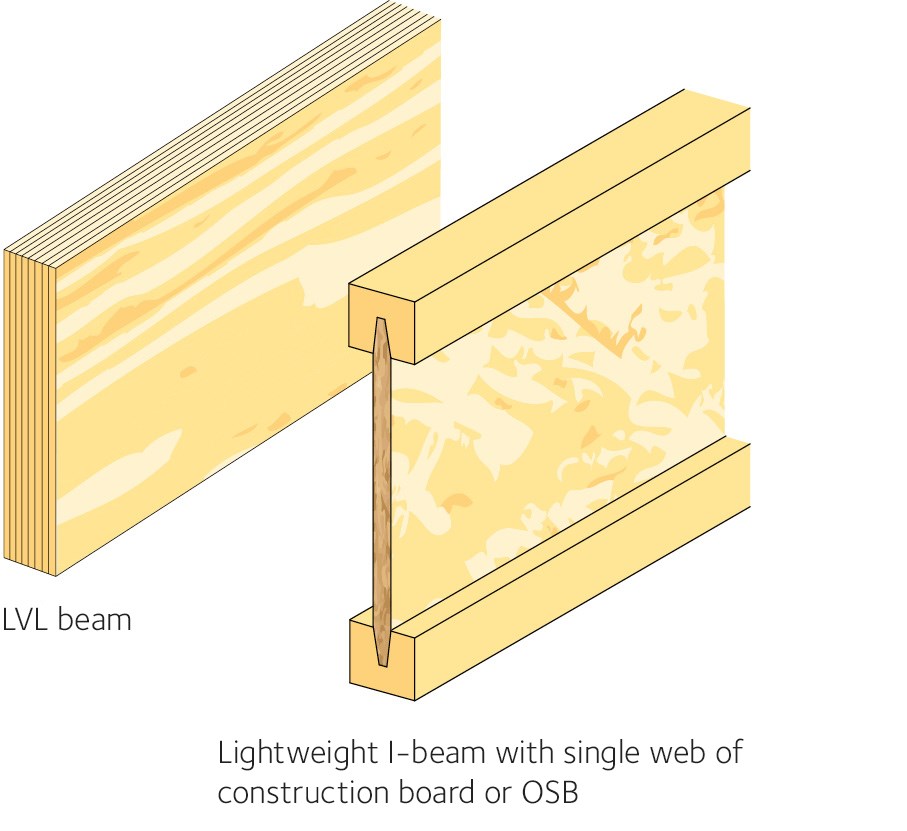
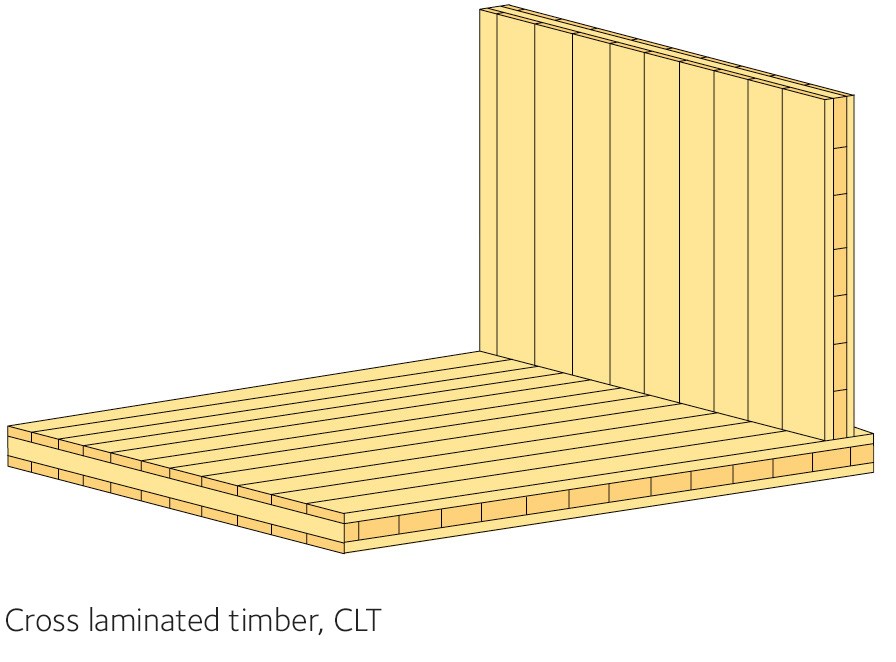
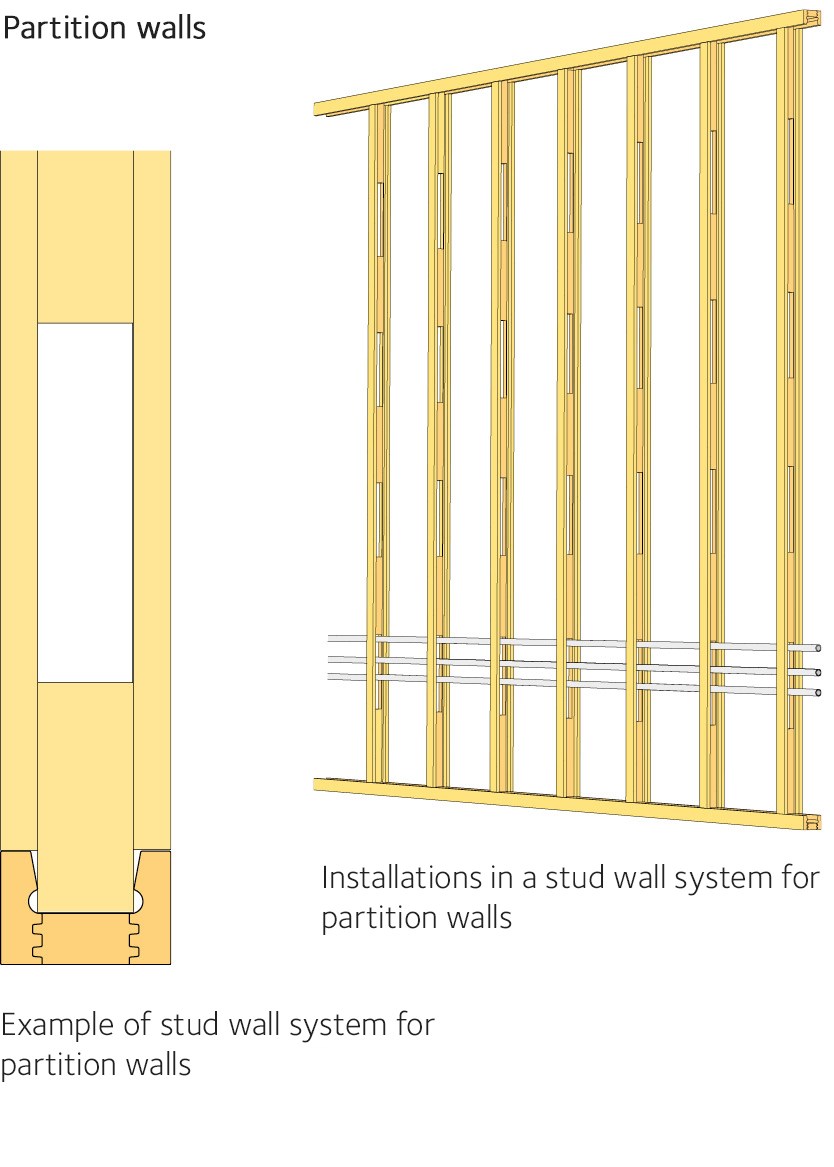
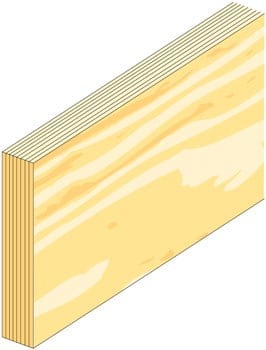
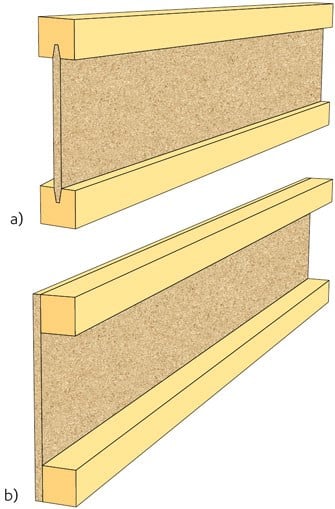
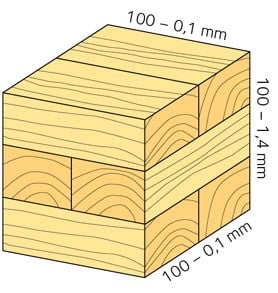
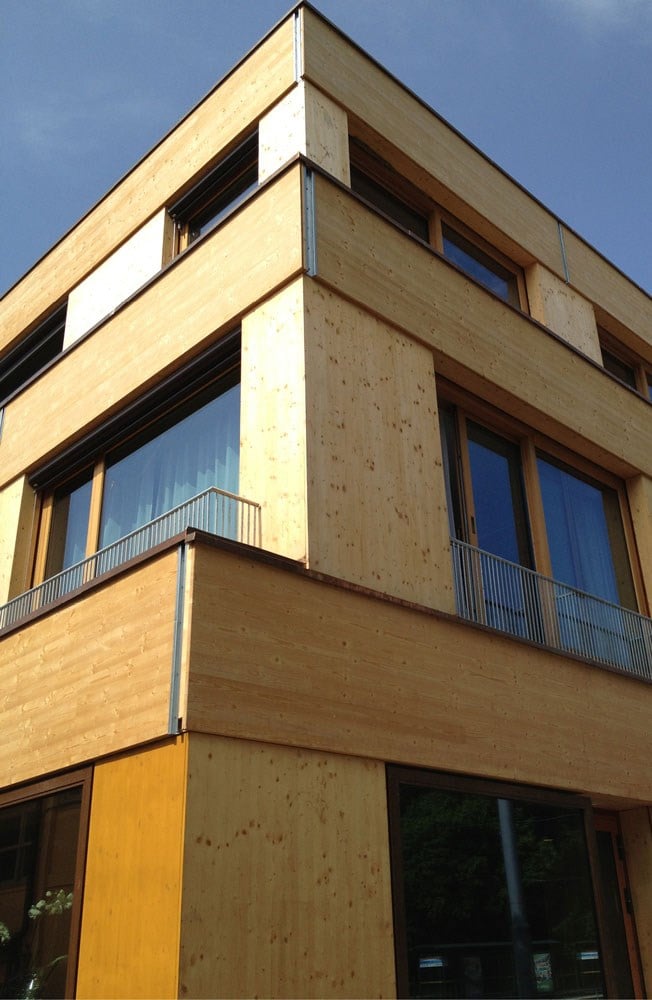 Abba-museet, Stockholm.
Abba-museet, Stockholm.